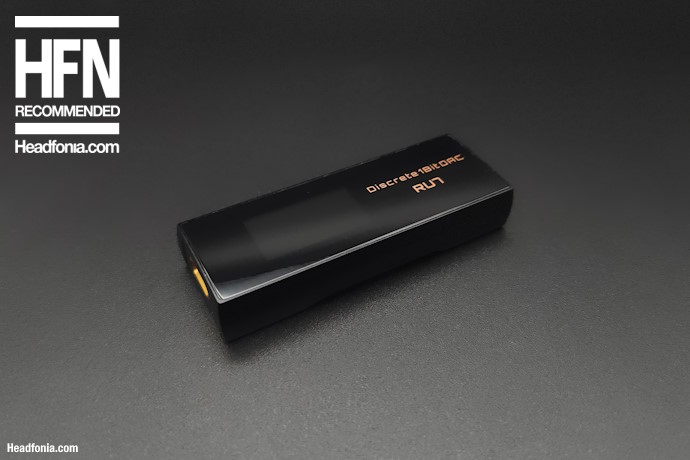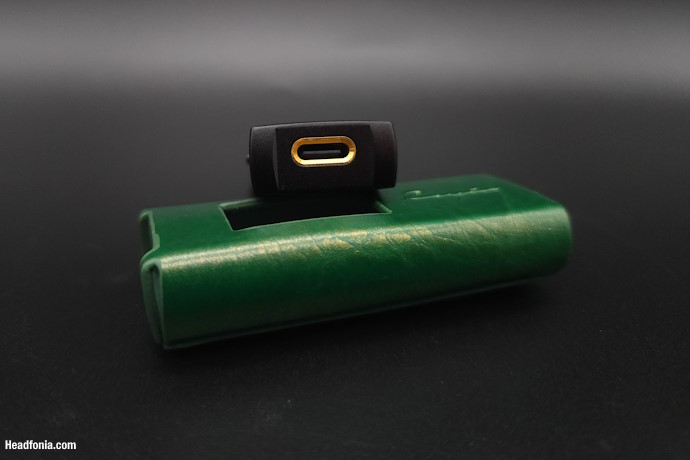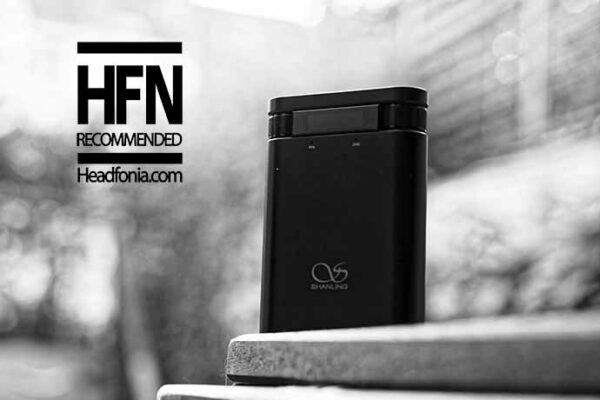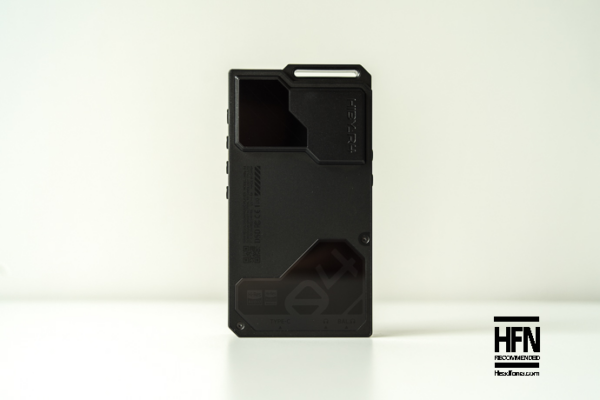Versatility & Usability
You really don’t need the manual to figure out how the RU7 works and what’s inside the menu. My RU7 out of the box was set to the highest gain and max volume, watch out for that.
The Cayin RU7 was developed to consume only little power, making it compatible with all of the most common platforms. The discrete resistor network basically is a low-power consuming DAC circuit when comparing it to other integrated DAC chipsets, minimizing power drain from your mobile source. The redesigned amplification circuit increases the output power while maintaining the overall power drain at around 100-110mA. I didn’t test this though, this info is coming directly from Cayin.
The RU7 is compatibles with Android based mobile devices, as well as iOS and iPad OS mobile devices, macOS computers, Windows 7/8/8.1/10/11 computers and Digital Audio Players with USB Audio output. I myself used the RU7 with my Windows 11 laptop running ROON (install the drivers first) as well as my Samsung Fold 4 Android phone. I had no issues whatsoever using the RU7 and the volume controls worked perfectly. The RU7’s audio drivers can be downloaded here.
Working with the RU7 is easy and once you set the correct gain and preferred output (and DSD level), you can blindly use the RU7 at all times. The RU7 gets a little bit warm, though nowhere near the level of the N7. It’s perfectly safe to use with the case and in your pocket or bag.
Another thing I want to mention here is the magnetic case and the 2 circular metal plates with adhesive tape pad. If you like me use the RU7 in a desktop environment and you hate that the RU7 is moving all over the place, you can simply stick the pads to your preferred desktop position and place the RU7 on them. Of course the magnets aren’t super strong, but it does help a lot. I like the option.
Last, I want to come back to the 100 steps volume control through 3 segments. When you switch to a segment, the sound cuts out for a longer time than you’re used to. Don’t worry about that, it’s normal. It didn’t bother me at all, but I actually hardly was going to different segments volume-wise.
Sound – General
As usual I have tested the RU7 with a whole series of possible sources, IEMs and headphones. Music came from my local library and was streamed from Tidal.
It’s very obvious that the Cayin RU7 has a more neutral tuning where the clarity and precision from the &Bit resistor ladder technology play an important role. At the same time Cayin has managed to tune the RU7 in an analog and musical way.
What I absolutely love about the RU7 are the 3-dimensionality and the immersive sound. You always feel the sound is everywhere/all around you. Another eye- (or should I say ear-) catcher, is the technical level this dongle produces. You get great clarity, mixed with impressive PRaT, a high resolution and sublime precision. The soundstage both in width and depth is good, and the layering is exemplary
As said the sound signature is analog-like and natural to the ear. It’s a very easy to listen to kind of tuning, and with it’s natural timbre, spacious presentation and note extension, it’s a pleasure to the ear. The RU7 will not create listening fatigue in any way.
As explained in the RU7 chapter, the software allows you to set the PCM to DSD level between 64, 128 and 256. The audible difference is there when switching between these 3 modes, but the difference is limited. Basically the sound stage, spaciousness and extension improves the higher you go, with the biggest change being between 64 and 128. I wouldn’t worry too much about this, just set it once to what you prefer and leave it there. I keep mine at 256.
Sound – Classics
With its neutral character, the RU7 is not specially boosting any specific frequencies and you get the same amount of body from top to bottom. The technical level is also the same everywhere.
Bass has a good amount of body, but it’s never exaggerated and the RU7 controls it perfectly. Bass reaches down low when needed and shows up when it’s called for. Bass layering and timbre, as well as resolution is really nice.
The mids perfectly connect to the bass section for what concerns body and impact. The mids are nicely spacious, have impressive timbre and a really 3D feeling (immersive). The vocals are perfectly integrated and everything is delivered with a precise, dynamic and natural tone.
The treble section extends nicely and is as present as the bass and mids. Everything sounds clear, airy and extended, with a good resolution and layering.
The RU7 is a top performer on all fronts, and one of the best performing dongles on the market, certainly at this price point.
Sound – Driveability
As said earlier, the RU7 (@32Ohm) produces up to 400mW in balanced mode and in Single-Ended mode you get 160mW. That means the RU7 shouldn’t have any issues at all with 99% of the IEMs on the market. I never felt it was underpowering any of my earphones and never had the need to go to a higher gain setting.
When I go to my day job’s office I always take a full-sized headphone with me as it’s easier to work with. Usually I have the Mojo 2 with me but I’ve been using the RU7 ever since it arrived. The headphones I tested the RU7 with aren’t the most difficult to drive, but they do scale up when connected to a portable amp or desktop amp. For this section I selected 3 of the most popular headphones on the market right now (I tried more)
The first headphone is the Sennheiser HD 660 S2. I’ve heavily been using this headphone since it was released and I find it to be a great all-rounder, that works with basically any amp. Of course it sounds better from say the Auris HA2-SE+ tube amp, but it also sounds perfectly nice straight from my laptop’s 3.5mm output. With the Cayin RU7, I prefer using the HD 660 S2 in high gain from the balanced output. In low gain the Senn is a bit light sounding and it hardly has any body or bass impact. Switching to high gain fixes that and you get a pleasant, very clean and precise signature. The HD 660 S2 is very musical sounding connected to the RU7, with a more neutral presentation. The combo is highly revealing, fast and clean. The RU7 is in perfect control. Where it lacks compared to a better desktop amp, is in the layering, depth, extension and decay areas. It’s a good combo but the HD 660 S2 can clearly perform better with a higher-end, desktop amp.
The second headphone I used is the closed-back Meze Audio Liric, as I sometimes need more isolation if I need to be fully concentrated. Like with the Senn, I prefer using the Liric in high gain, connected to the balanced output. I do find this combo to work very well together. Where the Senn sounds OK but is underperforming, I absolutely don’t get that feeling with the Liric. You get good body, impressive bass impact, excellent control and a really good level of precision. Where the Senn combo had issues with depth, layering and extension, this Liric performs very well in these areas. Musical, engaging and a good technical level, it’s the Meze Liric at its best. It’s a fully recommended combo.
The Hifiman Arya Stealth is an extremely popular headphone and if you’ve ever listened to unit, you immediately know why. Again here I prefer the 4.4mm output in high gain, even though low gain is nice if you like a little less bass presence. Like the Liric, this combo really works well together with a good amount of body, engaging bass presence and good precision. The clarity, note extension and cleanness here in this combo are a little less proficient, but it makes up for that with its depth, layering and musicality. While the Arya Stealth can still sound better on a high-end amplifier, the difference here isn’t the biggest. As such it’s also a recommended combo.
All-in-all I would advise to use only the more easy to drive full-sized headphones in combinations with the RU7. The headphone I love most myself on the RU7 is the Meze Liric, the synergy there is just right. Let us know in the comments below which headphone you feel has great synergy with the RU7.
The review continues on the second page. Click here or use the easy jumps below.
Page 1: Cayin, RU7, Features, 1-Bit, Packaging & Accessories, Design, Build Quality, Lay-Out
Page 2: Versatility, Usability, Sound General, Sound Classics, Driveability
Page 3: Cayin RU6, Conclusion, Award, Summary












Lukas
Any chance u could compare R7 to mojo 2 with full size planars ? Also can u compare R7 vs Ifi Gold Bar, lotoo paw S2
Alex Di Lolli
Great review, do you have some IEM you would recommend that would be a good pairing for the RU7?
Lieven
Any UM IEM
Mahesh
I have a Senns hd660S2. I read you didn’t tag it as “recommended combo” with RU7. Is there any other portable amp/dac that you would recommend for it? My usage style needs a portable one rather than desktop. So. Do reply when free. Thanks.
Orcun
comparison of hiby fc6,fc7 and cayin ru7, i didn’t understand anything. dsd r2r performance, upscaleing, resampling performance, one of them convert all, other switched button etc. mind blowing for ignorant. I’m interesting audiophilie but I have not understood anything since DSD, R2R, upscaling technologies were invented
which one is better spec with spotify? not joking, seriously asking
Alex
1. Switch to Tidal
2. Get Cayin RU7.
That’s it